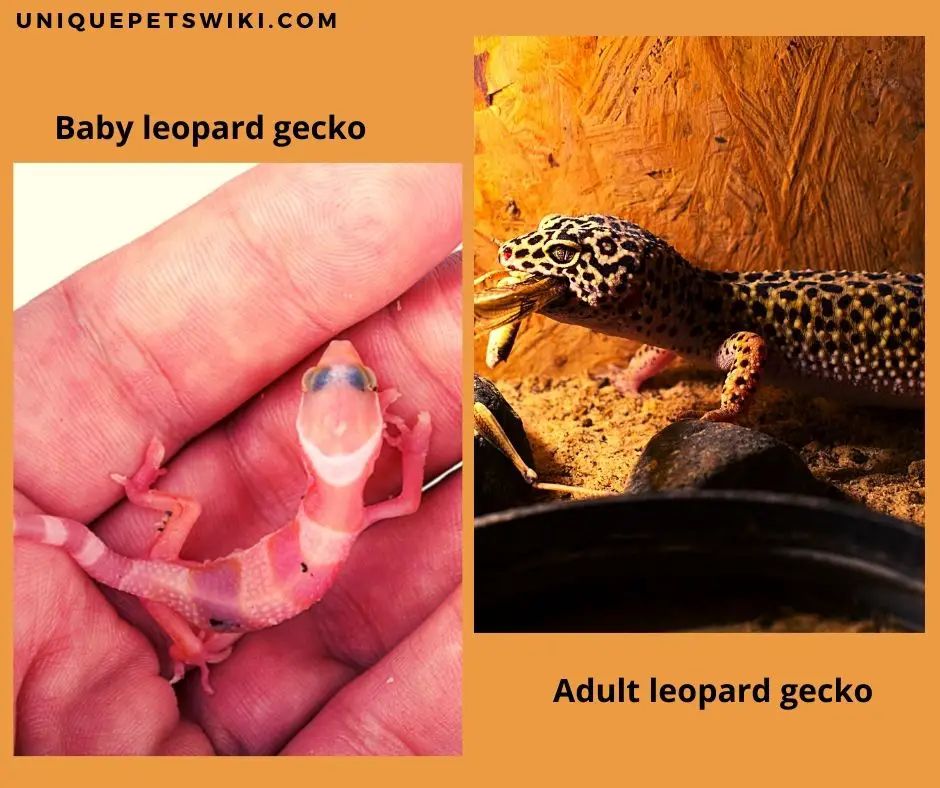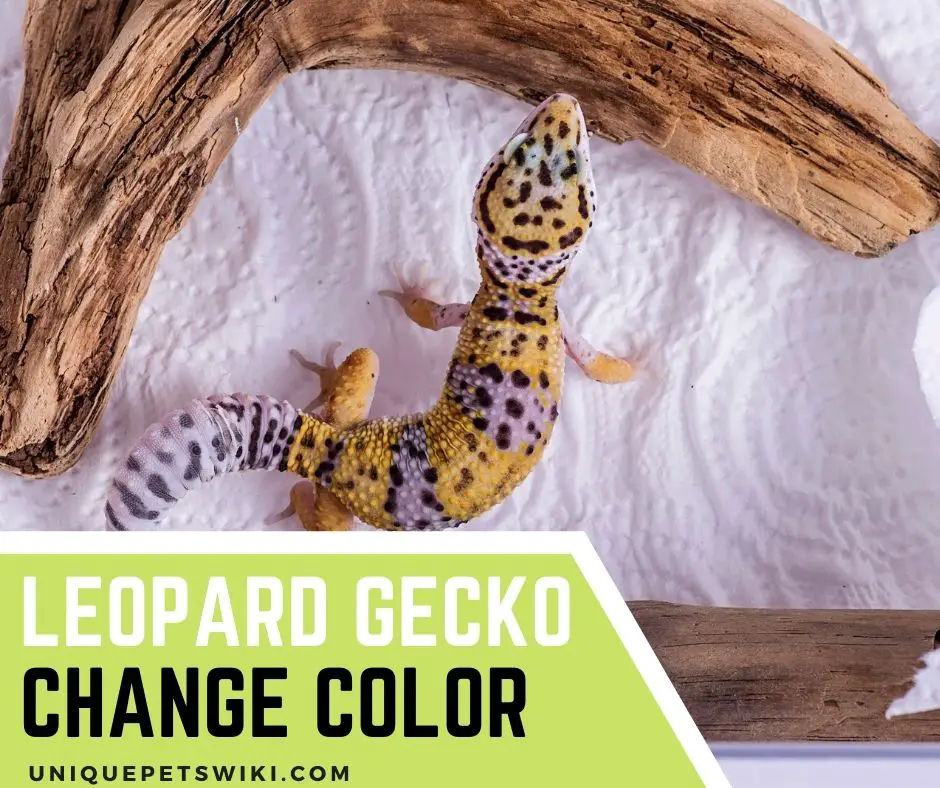New owners and experts will find it surprising and confusing when they discover their leopard gecko changed color. Unlike chameleons, leopard geckos don’t change color to help blend with their surroundings. There are several other reasons leopard geckos change colors which you didn’t know. Read on to learn more!
Generally, color change in leopard geckos is not a big issue if your gecko is eating, pooping, and moving around their enclosure. You can only be worried when your leopard gecko is showing any sign of discomfort.
In this article, we will highlight some of the reasons why leopard geckos change color, what this means, and what you can do.
This article has been reviewed by Dr. Gospel. Read more about our knowledge control process here.
Contents
Why Did Your Leopard Gecko Change Color?
There are several reasons why leopard geckos can change color. However, the two main reasons why leopard geckos change color is when shedding or when growing up. Leopard geckos can change to a white, purple, pink, black, or dull color.
2 Normal Cause When Leopard Gecko Change Color
The common reason why leopard geckos change color is during shedding and as they grow up.

Leopard Gecko Shedding
Like other reptiles, leopard geckos will shed their skin as they grow up. A fascinating thing about leopard geckos is that they can change color when shedding. Baby and juvenile leopard geckos grow rapidly and usually shed frequently (every 3-4 weeks), while adults shed once every few months.
Colors Of Leopard Gecko And Other Signs
Leopard gecko skin can turn whitish-gray when it gets ready to shed. Their skin will feel papery to touch, and once it feels loose, then your reptile will soon shed its skin. You don’t have to worry when your gecko changes to whitish-gray and should avoid peeling the skin from your pet unless there is a complication.
You can become worried when your leopard gecko starts turning purple. This happens when your leopard gecko experiences a problem shedding its skin and clogged up skin. Leopard geckos can lose their toes if this happens as blood circulation is cut off from the toes.
What You Can Do
When you notice your gecko is changing color to whitish-gray, the best thing to do is to create a separate shelter for your gecko. Your gecko loves a dark and moist hiding area to help shed its skin. It is best to use moist peat moss or cypress mulch as a substrate for the hide.
Once you provide this, your gecko can easily pull away from their skin with their mouth and can even eat it. However, there are times when your leopard gecko can have a problem shedding off parts of its skin. When this happens, you can then help your gecko to remove the stuck shed.
Before you attempt to remove the skin, ensure that you soak your gecko in warm water for 30 minutes. This will help to soften the skin, and you can use a pair of tweezers to remove the skin.
If you feel that your gecko is suffering from improper sheds regularly, you can take it to the vet for diagnosis.
Your Leopard Gecko Is Growing
Generally, leopard geckos can change color as they age. This occurrence is common when your leopard gecko is a year older.

Colors Of Leopard Gecko And Other Signs
Baby leopard geckos usually develop spots as they grow older. Leopard geckos’ color can change up to when they are 12-18 months old. This means your gecko skin usually turns darker as you grow older.
Some leopard gecko morphs like patternless, carrot tail, and orange morphs usually become darker or lose some of their markings when they are 1-3 years old. However, most leos usually have a full marking once they mature, and their stripes can become darker.
What Owners Can Do
Growing up is an important aspect of leopard geckos, and all you can do is to provide an adequate diet and keep their enclosure at an optimal level.
Other Causes Of Leopard Gecko Change Color
Apart from shedding and growing up, leopard geckos can also change color due to several reasons. Some of the uncommon reasons why leopard geckos change colors are:
- Improper supplementation and nutritional deficiencies
- Your leopard gecko is stressed
- There is a temperature imbalance in your gecko’s tank
- You are using the wrong substrate
- Overexposure to UV light
Improper Supplementation And Nutritional Deficiencies
One of the causes of color change in leopard geckos is nutritional deficiencies. Your leopard gecko can have a dark yellow coloration if it has a calcium deficiency. Once you notice this, it is best to address it immediately by supplementing their diet and providing access to UV light for your gecko.
The two ways to supplement your leopard gecko are gut-loading the feeder insects 24-48 hours before feeding your gecko and dusting the feeder insects before you feed your gecko.
You can also place calcium powder in your leopard gecko enclosure, where they can lick it to help reduce calcium deficiency risk. However, many hobbyists believe that leopard geckos’ color can change to pink because of improper supplementation.
The pink color may indicate that your gecko is suffering from a calcium overdose. Other signs of calcium overdose include twitchy toes, lethargy, and lack of appetite. Once you notice this, you should try to remove the calcium powder from their tank.
Your Leopard Gecko Is Stress
Sometimes, leopard geckos can turn darker when stressed. There are several reasons that can cause stress in leopard geckos, such as diet, tank size, wrong temperature, handling, etc. Once you notice that your leopard gecko is stressed, the best thing to do is determine what causes them stress and address it.
You can also prevent stress by ensuring the condition in your leopard gecko’s enclosure is at optimal range. There should be a warm and cold spot in their enclosure, and the temperature should be at optimal range. Leopard geckos will also need an under-tank heater to help digest their food.
Another thing is to follow the day and night cycle when using a UVB light. You should also avoid handling your leopard gecko for a long time to help ensure it is not stressed. A proper diet that is supplemented should be provided, and you can create a feeding schedule for your leopard gecko.
Temperature Imbalance: Temperature In Tank Is Low
A leopard gecko can turn brown when the temperature in or outside of its tank is low. Leopard geckos change color to brown or black to help them absorb as much heat they can get. You can prevent this by ensuring the temperature in their enclosure is at the ideal range.
There should be a temperature gradient (warm and cool sides) in your leopard gecko’s enclosure. The warm side should be around 83-90oF, while the cool side should be around 70-77oF during the day. With this, your leopard gecko can easily move to the warm spot whenever it is cold.
The nighttime temperature in their enclosure should be between 70-74oF and should not go lower than 66oF. You can ensure the temperature is ideal by regularly checking the cool and warm sides’ temperature.
It is also recommended that you place a warm hideout close to the basking lights where your leopard gecko can easily hide from the light whenever they like.
The Substrate Is Wrong
There are substrates in the market that can turn leopard gecko brown. Some substrates with darker hues, such as dark sand and coco fiber, are the common cause of this problem. Many hobbyists believe that these substrates can cause high humidity, making your leopard gecko look duller.
Furthermore, avoid using sphagnum moss or vermiculite as bedding for the whole of your gecko’s enclosure. This is because they also increase humidity, and it is best to use them only in a shedding box for your leos.
Apart from causing color change, using the wrong substrate can also lead to several health problems. Using loose substrates for your leopard gecko’s enclosure can cause impaction. This means loose substrates like sand, pebbles, and even coco fiber can cause impaction if your gecko accidentally ingests them.

Too Much UV Exposure
Generally, it is not necessary to use a UVB lamp for your leopard gecko’s enclosure. This is because leopard geckos do not bask like other reptiles like bearded dragons. However, many people still use them as a heat source for their pets.
Exposing leopard geckos to too much UVB light can lead to skin darkening in leopard geckos. This is very common in leopard gecko morphs with reduced melanins like albino morphs.
As a responsible owner, you should try to limit the use of UVB lamps in your gecko’s enclosure. However, if you plan to use them, you can try to reduce UVB exposure by interchanging between a UVB lamp and a heating mat.
Another alternative way to avoid overexposure to UVB light for your gecko is by providing several hiding spaces in their enclosure.
Last Sentences
It is quite common for a leopard gecko to change color. You can put your mind at rest if your leopard gecko changes color, which does not affect their habits like feeding, movement, etc. Leopard geckos can change color due to growth, when shedding, low temperature, wrong substrate, etc.
We hope we have answered all your concerns about leopard gecko color change. If you have any questions or comments about leopard gecko color change, you can do so in the comment section below.
